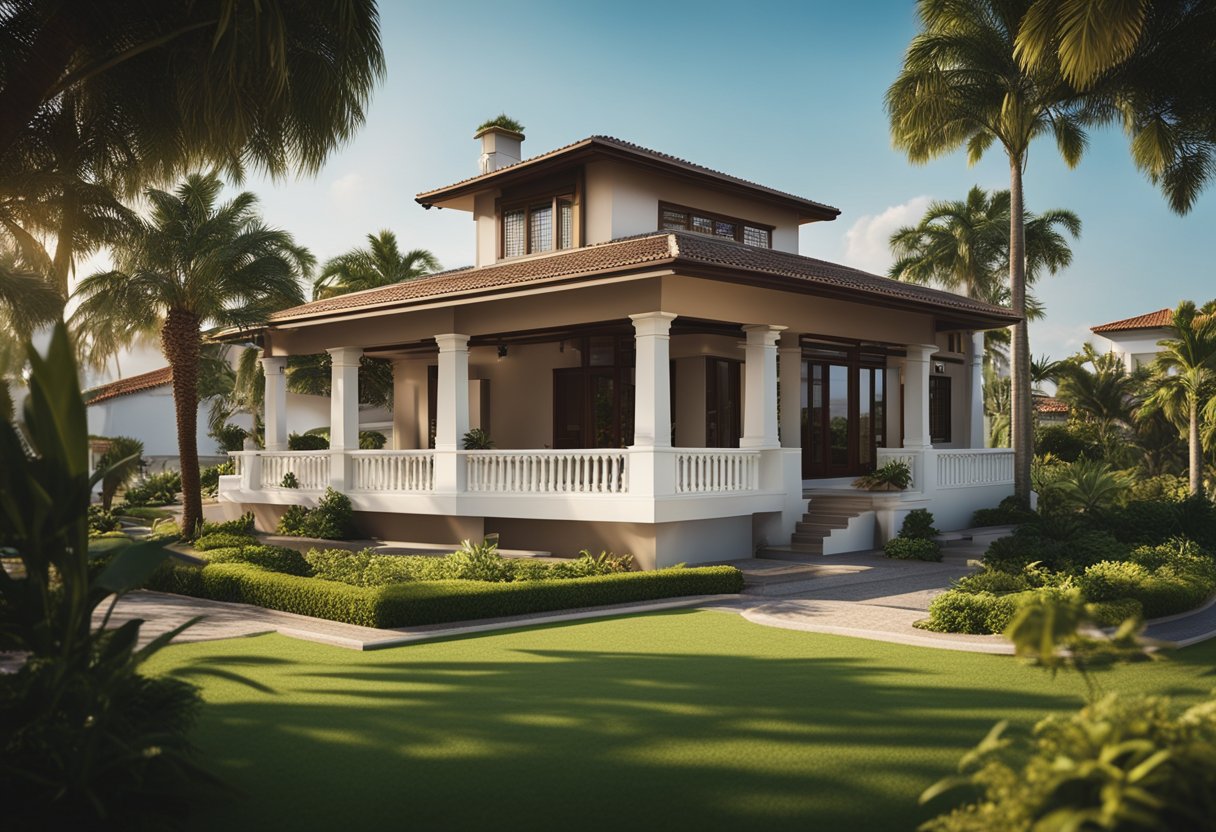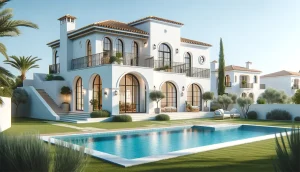A villa and a bungalow are both types of houses that are commonly found in residential areas. Although these two terms are often used interchangeably, they actually have distinctive differences in terms of their design, size, and amenities. Understanding the difference between a villa and a bungalow can help homeowners make informed decisions when choosing the type of property that best suits their needs.
A villa is typically a large, luxurious house that is often used as a vacation home or rental property. It usually has multiple levels and amenities such as a pool, garden, or tennis court. On the other hand, a bungalow is a smaller, one-story house that is often more modest in design and amenities. While villas are often associated with high-end living and luxury, bungalows are often associated with simplicity and affordability. However, this does not necessarily mean that one type of house is better than the other. It all depends on the homeowner’s preferences and budget.
The Definition and Origin of Villas and Bungalows
Villas and bungalows are distinctive types of residential architecture, each with a unique history. Villas originated in ancient Rome, where they were luxurious country estates for the wealthy, designed for relaxation and leisure. Over time, the term evolved to describe grand, detached homes in rural or semi-rural settings, often featuring expansive gardens and elegant design.
Bungalows, on the other hand, have a simpler origin, with their roots tracing back to the Bengal region of India. The term “bungalow” refers to a single-story house with a low-pitched roof and a verandah, adapted by British colonists for its practicality and comfort. Today, both villas and bungalows continue to be popular choices, each offering distinct characteristics that cater to different lifestyles and preferences.

What Is a Villa?
A villa is a type of luxury residence, originally inspired by the grand country estates of ancient Rome. Traditionally, villas are spacious, detached homes set in picturesque or semi-rural locations, often surrounded by extensive gardens or landscapes. They typically feature elegant architecture, high-end finishes, and a focus on comfort and leisure.
In modern usage, the term “villa” has broadened to include various upscale properties, including vacation homes or luxury residences in desirable locations. Despite this evolution, villas generally maintain their association with exclusivity, spaciousness, and an emphasis on outdoor living and relaxation.
What Is a Bungalow?
A bungalow is a single-story house characterized by its simplicity and practicality. Originating from the Bengal region of India, the term “bungalow” refers to a home with a low-pitched roof, often featuring a verandah or porch that wraps around the house. Bungalows are designed for easy accessibility and often have a compact, efficient layout that eliminates the need for stairs.
Modern bungalows maintain these features but can vary widely in style and size. They are popular for their convenience and ease of maintenance, making them a favored choice for those seeking a straightforward, one-level living experience.
Architectural Features of Villas and Bungalows
Villas and bungalows each have distinct architectural features that reflect their historical origins and design philosophies.

Villas:
- Spacious Layout: Villas are known for their expansive interiors, often including multiple rooms, high ceilings, and large windows that offer panoramic views of the surrounding landscape.
- Elegant Design: They frequently feature sophisticated architectural details such as ornate facades, grand entryways, and luxurious materials like marble and wood.
- Outdoor Spaces: Villas typically boast extensive gardens, private swimming pools, and outdoor living areas designed for relaxation and entertainment.
- Classic Elements: Traditional villas might include elements like columns, arches, and tiled roofs, while modern villas can showcase sleek, contemporary designs.
Bungalows:
- Single-Story Layout: Bungalows are characterized by their single-story design, eliminating the need for stairs and making them accessible to all.
- Low-Pitched Roof: They often have a low-pitched, overhanging roof that extends to cover a front or side porch.
- Verandah or Porch: A prominent feature is the verandah or covered porch that provides outdoor living space and enhances the connection with nature.
- Simple, Functional Design: Bungalows generally emphasize practicality and efficiency, with open floor plans and straightforward design elements.
Cultural and Regional Variations of Villas and Bungalows
Cultural and regional influences have profoundly shaped the design and features of both villas and bungalows.
Cultural and Regional Variations of Villas:
- Mediterranean Villas: Originating from the Italian Renaissance, these villas are known for their stucco exteriors, tiled roofs, and ornate detailing. They often include courtyards, fountains, and lush gardens.
- Spanish Villas: Reflecting Moorish influences, Spanish villas often feature red-tiled roofs, wrought-iron details, and colorful ceramic tiles. They frequently incorporate courtyards with lush vegetation and water features.
- Modern Villas: In contemporary settings, villas can vary widely but often emphasize minimalistic designs with clean lines, expansive glass walls, and open floor plans. They are frequently located in exclusive neighborhoods or resorts.
Cultural and Regional Variations of Bungalows:
- American Bungalows: The American Craftsman bungalow, popular in the early 20th century, features exposed wooden beams, built-in furniture, and extensive use of natural materials. These bungalows often have overhanging eaves and large front porches.
- British Bungalows: In the UK, bungalows are often characterized by their simple, functional design with a focus on accessibility. They typically have a compact layout with a modest, low-pitched roof and may include a small garden.
- Indian Bungalows: Influenced by colonial design, Indian bungalows often feature verandahs or wrap-around porches, high ceilings, and large windows to accommodate the tropical climate. They combine practical features with decorative elements such as carved woodwork and terracotta tiles.
These variations highlight how villas and bungalows adapt to different climates, cultures, and aesthetic preferences while maintaining their core characteristics.
Functionality and Uses of Villas vs. Bungalows
Villas and bungalows are both types of residential buildings, but they serve different functions and are suited to different needs and preferences. Here’s a comparison of their functionality and uses:
Villas
Functionality:
- Space and Luxury: Villas are typically larger and designed for comfort and luxury, often including multiple bedrooms, expansive living areas, and high-end amenities such as private pools, gardens, and entertainment areas.
- Privacy: They offer a high level of privacy due to their often detached nature and large plots of land.
- Design: Villas can be built in various architectural styles and are often tailored to reflect the owner’s taste or the local culture.
- Flexibility: They are suitable for extended families or groups, with ample space for gatherings and separate areas for guests.
Uses:
- Primary Residences: In upscale neighborhoods or communities, villas serve as luxurious primary residences.
- Vacation Homes: Villas are popular as vacation homes or rental properties in desirable destinations, offering a high level of comfort and amenities.
- Entertainment and Events: Their spacious and well-appointed nature makes them ideal for hosting events, parties, or family gatherings.
Bungalows
Functionality:
- Single-Story Layout: Bungalows are usually single-story homes, which can be advantageous for accessibility and ease of movement, especially for individuals with mobility issues or families with young children.
- Compact Design: They typically have a simpler, more compact design compared to villas, often including a smaller footprint and fewer rooms.
- Accessibility: The lack of stairs makes bungalows more accessible and easier to maintain.
Uses:
- Primary Residences: Bungalows are often used as primary residences, particularly in suburban or rural areas where space is less constrained.
- Retirement Homes: Their single-story design makes them a popular choice for retirees who prefer not to deal with stairs.
- Smaller Families or Individuals: They are ideal for small families, singles, or couples who do not need extensive space or luxury features.
In summary, while villas are associated with luxury, space, and privacy, making them suitable for a range of functions from primary residences to vacation homes, bungalows offer practical benefits like accessibility and a compact design, catering to different lifestyle needs.
Economic Aspects of Villas vs. Bungalows
The economic aspects of villas and bungalows can vary significantly based on several factors, including construction costs, property values, and maintenance expenses.
Villas:
- Construction Costs: Villas are typically more expensive to build due to their larger size, luxury finishes, and complex architectural details. High-end materials, extensive landscaping, and additional amenities such as pools or spas contribute to higher costs.
- Property Values: Villas, especially in desirable locations, often have higher property values. They are considered premium properties and can command a significant price premium compared to other residential types.
- Maintenance Expenses: The upkeep of a villa can be costly due to its size and the maintenance of extensive outdoor areas. Regular care of gardens, pools, and other luxury features can add to ongoing expenses.
Bungalows:
- Construction Costs: Bungalows generally have lower construction costs compared to villas because they are smaller, simpler structures with fewer luxury elements. Their single-story design also reduces the complexity of construction.
- Property Values: The value of bungalows can vary widely based on location and size but is often lower than that of villas. They are typically considered more affordable and accessible, making them attractive to a broader range of buyers.
- Maintenance Expenses: Bungalows tend to have lower maintenance costs due to their smaller size and simpler design. There is less need for extensive landscaping or upkeep of large outdoor spaces, which can make them more economical in the long run.
Overall, while villas represent a higher investment with greater ongoing costs, bungalows offer a more economical alternative with lower construction and maintenance expenses.
Pros and Cons of Villas and Bungalows?
Villas:
Pros:
- Luxury and Space: Villas offer expansive living areas, high-end finishes, and luxurious amenities such as private pools, extensive gardens, and spacious interiors.
- Privacy: They are typically located in exclusive areas with large plots, providing a high level of privacy and seclusion.
- Customization: Villas often allow for greater customization and personal design touches, catering to specific tastes and preferences.
Cons:
- High Cost: Villas are generally more expensive to purchase, build, and maintain, making them less accessible for many buyers.
- Maintenance: The large size and numerous amenities can result in high ongoing maintenance costs, including garden upkeep and pool management.
- Utility Expenses: Larger homes can lead to higher utility bills due to increased energy consumption for heating, cooling, and lighting.
Bungalows:
Pros:
- Accessibility: Bungalows offer single-story living, making them accessible for people with mobility issues and eliminating the need for stairs.
- Cost-Effective: They usually have lower construction and maintenance costs compared to villas, making them more affordable.
- Ease of Maintenance: The smaller size and simpler design generally result in lower maintenance and utility expenses.
Cons:
- Limited Space: Bungalows typically offer less living space and fewer luxury amenities compared to villas, which may be a drawback for those seeking more room.
- Resale Value: In some markets, bungalows may have lower resale values compared to larger, more luxurious properties.
- Design Limitations: The single-story design might limit the architectural variety and expansion possibilities that multi-story homes offer.
Both villas and bungalows have distinct advantages and disadvantages, and the choice between them depends on individual needs, preferences, and financial considerations.
Related Posts
- Villa vs Mansion: What is the Difference?
- What Is The Difference Between A Villa and An Apartment?
- What Is The Difference Between A Flat and An Apartment?
Personal Considerations: Choosing Between a Villa and a Bungalow
Choosing between a villa and a bungalow involves evaluating personal needs, lifestyle preferences, and financial considerations. Here are key factors to consider:
- Lifestyle and Space Requirements: If you value spacious living areas, luxury amenities, and privacy, a villa might be the better choice. Villas are ideal for those who entertain frequently, enjoy extensive outdoor spaces, or need room for large families. Bungalows, with their single-story layout, offer a more compact and accessible living environment, which can be ideal for those seeking simplicity or for individuals with mobility concerns.
- Budget: Villas often come with a higher price tag, both in terms of purchase cost and ongoing maintenance. Consider your budget for both the initial investment and long-term expenses. Bungalows generally offer a more affordable option, with lower construction and upkeep costs.
- Maintenance: Evaluate your willingness and ability to maintain the property. Villas, with their extensive grounds and luxury features, require more upkeep, including garden care and pool maintenance. Bungalows typically involve less maintenance, making them easier to manage and more cost-effective.
- Future Plans: Think about your long-term plans and how the property will fit into them. Villas may offer more opportunities for customization and expansion but can be more challenging to manage as you age. Bungalows provide ease of access and may be better suited for aging in place or if you plan to downsize in the future.
- Location and Community: Consider the location and the type of community you want to be part of. Villas are often situated in exclusive neighborhoods or resorts, offering a luxurious lifestyle but sometimes at a higher cost of living. Bungalows are commonly found in a variety of neighborhoods and can be more integrated into residential communities.
By thoughtfully evaluating these factors, you can select a home that best suits your needs, preferences, and financial situation. If you’re interested in villas, explore Gaursons’ exclusive luxury options on the Yamuna Expressway, Greater Noida West:
- Gaur Aero Villas: Known for their modern design and spacious interiors, perfect for contemporary living.
- Gaur Sports Villas: Designed for sports enthusiasts, equipped with top-notch facilities and amenities.
- Gaur Lakeshore Villas: Providing stunning views and a peaceful setting, ideal for a serene lifestyle.
- Gaur Krishna Vilas: Combining sophistication with modern amenities, offering a refined and comfortable living experience.
Each of these villas provides a distinctive living experience, integrating luxury and comfort to meet the highest standards of modern living.
FAQs: Villa vs. Apartment – What’s the Difference?
1. What defines a villa compared to an apartment?
Villa: A villa is a standalone, often luxurious house with more space, privacy, and amenities, typically located in upscale or resort areas.
Apartment: An apartment is a self-contained unit within a larger building or complex, sharing walls with neighboring units and often offering less space and privacy compared to a villa.
2. Are villas generally more expensive than apartments?
Yes, villas are generally more expensive due to their larger size, increased privacy, and additional amenities. They are often situated in desirable locations and offer more extensive features.
3. What should I consider when choosing between a villa and an apartment?
Consider factors like your budget, desired level of privacy, maintenance responsibilities, space requirements, location preferences, and whether you want access to additional amenities.
4. Do villas offer more privacy than apartments?
Yes, villas generally offer more privacy as they are standalone properties with private grounds, while apartments are part of a larger building and have shared walls and common areas.
5. Are villas or apartments better for investment purposes?
This depends on market conditions and investment goals. Villas can offer higher rental yields and long-term value due to their exclusivity and location, while apartments might provide more consistent rental income and lower entry costs.




